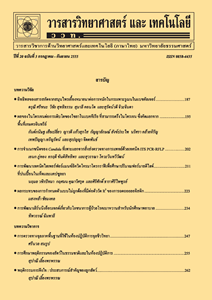องค์ประกอบทางเคมีจากกิ่งสะทอน
Main Article Content
Abstract
The twigs of Millettia utilis Dunn. were extracted, using dichloromethane. Then crude extracts were isolated by column chromatography over silica gel and eluted with hexane, dichloromethane, ethyl acetate and methanol. The structure elucidation of 3 obtained compounds were revealed by NMR technique. For known compounds were compared with previous reported in literatures. Compound 1 and 2 were triterpenes, i.e. erythrodiol and lupeol, respectively, while compound 3 was a steroid, stigmasterol.
Article Details
Issue
Section
Physical Sciences
References
[1] Temsirireagkul, R., Saraya, S., Wongkrachang, Y., Ruangwiset, N. and Chuokul, W., 2005, A Project to Study Preservatives from Herbs to Extend the Product of Community Chili Paste, Department of Pharmacy, Faculty of Pharmacy Mahidol University, Bangkok, 50 p. (in Thai)
[2] Huo, X., Zhang, L., Gao, L., Guo, Y., Zhang, L., Li, L., Si., J. and Cao, L., 2015, Antiinflammatory and analgesic activities of ethanol extract and isolated compounds from Millettia pulchra, Biol. Pharm. Bull. 38: 1328-1336.
[3] Kamto, E.D., Atchade, A.T., Marston, A., Pegnyemb, E.D. and Westhuizen, J.H., 2012, Chemical constituents from bark of Millettia mannii Baker (Papilionoideae-Leguminosae), Biochem. Syst. Ecol. 45: 98-101.
[4] Derese, S., Barasa, L., Akala, H.M., Yusuf, A.O., Kamau, E., Heydenreich, M. and Yenesew, M., 2014, 4-Prenyloxyderrone from the stem bark of Millettia oblata ssp. teitensis and the antiplasmodial activities of isoflavones from some Millettia species, Phytochem. Lett. 8: 69-72.
[5] Sritularak, B. and Likhitwitayawuid, K., 2006, Flavonoids from the pods of Millettia erythrocalyx, Phytochemistry 67: 812-817.
[6] Pancharoen, O., Athipornchai, A., Panthong, A. and Taylor, W.C., 2008, Isoflavones and Rotenoids from the Leaves of Millettia brandisiana, Chem. Pharm. Bull. 56: 835-838.
[7] Phrutivorapongkul, A., Lipipun, V., Ruangrungsi, N., Kirtikara, K., Nisikawa, K., Maruyama, S., Watanabe, T. and Ishikawa, T., 2003, Studies on the chemical constituents of stem bark of Millettia leucantha: Isolation of new chalcones with cytotoxic, anti-herpes simplex virus and anti-inflammatory activities, Chem. Pharm. Bull. 51: 187-190.
[8] Abbass, H.M., Ragab, E.A., Mohammed, A.E. and El-hela, A.A., 2015, Phyto chemical and biological investigations of Ficus mysorensis cultivated in Egypt, J. Pharm. Chem. Biol. Sci. 3: 396-407.
[9] Aktar, F., Kaisar, M.A., Kabir, A.H., Hasan, C.M. and Rashid, M.A., 2009, Phyto chemical and biological investigations of Ixora arborea Roxb, J. Phram. Sci. 8: 161-166.
[10] Wang, F., 1H-NMR Spectra of Common Triterpenoids (18 Compounds), Available Source: https://www.wangfei.ac.cn/article/nmrspectra/7/1/35, July 9, 2018.
[11] Laghari, A.H., Memon, S., Nelofar, A. and Khan, K.M., 2011, Alhagi maurorum: A convenient source of lupeol, Ind. Crops Prod. 34: 1141-1145.
[12] Kolak, U., Topcu, G., Birteksoz, S., Otuk, G. and Ulubelen, A., 2005, Terpenoids and steroids from the roots of Salvia blepha ronchlaena, Turk. J. Chem. 29: 177-186.
[13] Forgo, P. and Kover, K.E., 2004, Gradient enhanced selective experiments in the 1H NMR chemical shift assignment of the skeleton and side-chain resonances of stigmasterol, a phytosterol derivative, Steroids 69: 43-50.
[14] Douglas, K., Kiplimo, J.J. and Chirchir, D., 2016, Phytochemistry and antibacterial activity of extracts from medicinal plant Olea africana, Afr. J. Pharm. Pharmacol. 10: 330-336.
[15] Kangsamaksin, T., Chaithongyot, S., Woot thichairangsan, C., Hanchaina, R., Tangshewinsirikul, C. and Svasti, J., 2017, Lupeol and Stigmasterol Suppress Tumor Angio genesis and Inhibit Cholangiocarcinoma Growth in Mice via Downregulation of Tumor Necrosis Factor-, Available Source: https://journals.plos.org/plosone/ article?id=10.1371/journal.pone.0189628, July 19, 2018.
[16] Gallo, M.B.C. and Sarachine, M.J., 2009, Biological activities of lupeol, Int. J. Biomed. Pharm. Sci. 3(spec.): 46-66.
[2] Huo, X., Zhang, L., Gao, L., Guo, Y., Zhang, L., Li, L., Si., J. and Cao, L., 2015, Antiinflammatory and analgesic activities of ethanol extract and isolated compounds from Millettia pulchra, Biol. Pharm. Bull. 38: 1328-1336.
[3] Kamto, E.D., Atchade, A.T., Marston, A., Pegnyemb, E.D. and Westhuizen, J.H., 2012, Chemical constituents from bark of Millettia mannii Baker (Papilionoideae-Leguminosae), Biochem. Syst. Ecol. 45: 98-101.
[4] Derese, S., Barasa, L., Akala, H.M., Yusuf, A.O., Kamau, E., Heydenreich, M. and Yenesew, M., 2014, 4-Prenyloxyderrone from the stem bark of Millettia oblata ssp. teitensis and the antiplasmodial activities of isoflavones from some Millettia species, Phytochem. Lett. 8: 69-72.
[5] Sritularak, B. and Likhitwitayawuid, K., 2006, Flavonoids from the pods of Millettia erythrocalyx, Phytochemistry 67: 812-817.
[6] Pancharoen, O., Athipornchai, A., Panthong, A. and Taylor, W.C., 2008, Isoflavones and Rotenoids from the Leaves of Millettia brandisiana, Chem. Pharm. Bull. 56: 835-838.
[7] Phrutivorapongkul, A., Lipipun, V., Ruangrungsi, N., Kirtikara, K., Nisikawa, K., Maruyama, S., Watanabe, T. and Ishikawa, T., 2003, Studies on the chemical constituents of stem bark of Millettia leucantha: Isolation of new chalcones with cytotoxic, anti-herpes simplex virus and anti-inflammatory activities, Chem. Pharm. Bull. 51: 187-190.
[8] Abbass, H.M., Ragab, E.A., Mohammed, A.E. and El-hela, A.A., 2015, Phyto chemical and biological investigations of Ficus mysorensis cultivated in Egypt, J. Pharm. Chem. Biol. Sci. 3: 396-407.
[9] Aktar, F., Kaisar, M.A., Kabir, A.H., Hasan, C.M. and Rashid, M.A., 2009, Phyto chemical and biological investigations of Ixora arborea Roxb, J. Phram. Sci. 8: 161-166.
[10] Wang, F., 1H-NMR Spectra of Common Triterpenoids (18 Compounds), Available Source: https://www.wangfei.ac.cn/article/nmrspectra/7/1/35, July 9, 2018.
[11] Laghari, A.H., Memon, S., Nelofar, A. and Khan, K.M., 2011, Alhagi maurorum: A convenient source of lupeol, Ind. Crops Prod. 34: 1141-1145.
[12] Kolak, U., Topcu, G., Birteksoz, S., Otuk, G. and Ulubelen, A., 2005, Terpenoids and steroids from the roots of Salvia blepha ronchlaena, Turk. J. Chem. 29: 177-186.
[13] Forgo, P. and Kover, K.E., 2004, Gradient enhanced selective experiments in the 1H NMR chemical shift assignment of the skeleton and side-chain resonances of stigmasterol, a phytosterol derivative, Steroids 69: 43-50.
[14] Douglas, K., Kiplimo, J.J. and Chirchir, D., 2016, Phytochemistry and antibacterial activity of extracts from medicinal plant Olea africana, Afr. J. Pharm. Pharmacol. 10: 330-336.
[15] Kangsamaksin, T., Chaithongyot, S., Woot thichairangsan, C., Hanchaina, R., Tangshewinsirikul, C. and Svasti, J., 2017, Lupeol and Stigmasterol Suppress Tumor Angio genesis and Inhibit Cholangiocarcinoma Growth in Mice via Downregulation of Tumor Necrosis Factor-, Available Source: https://journals.plos.org/plosone/ article?id=10.1371/journal.pone.0189628, July 19, 2018.
[16] Gallo, M.B.C. and Sarachine, M.J., 2009, Biological activities of lupeol, Int. J. Biomed. Pharm. Sci. 3(spec.): 46-66.


